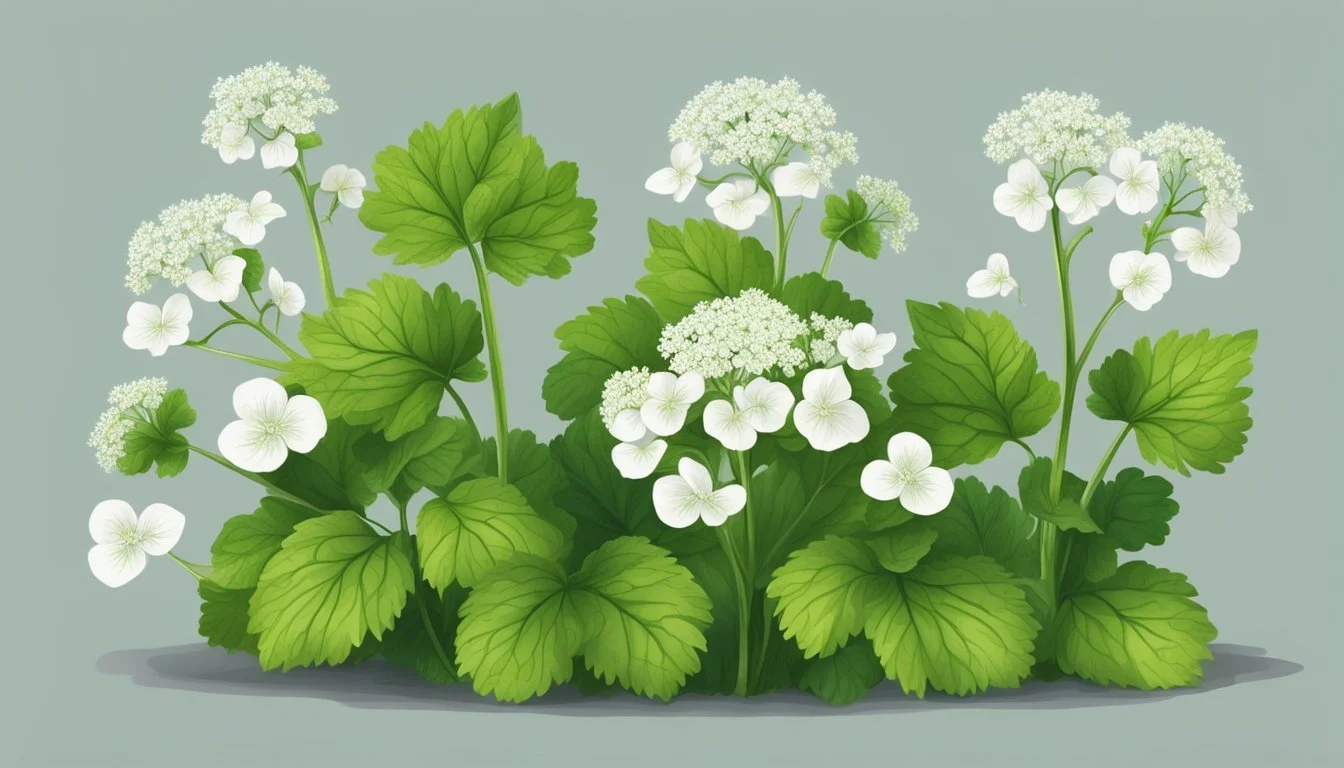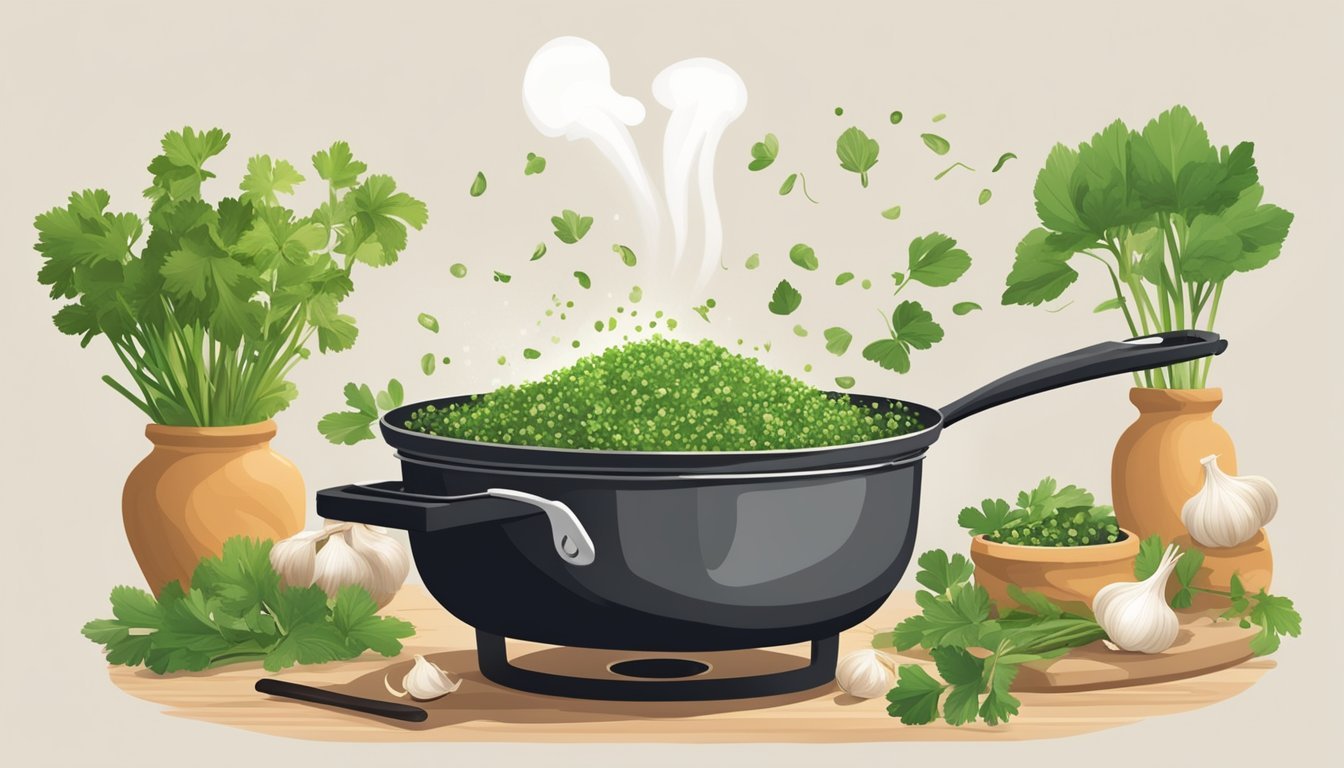Garlic Mustard Substitutes
Top Alternatives for Your Recipes
Garlic (What wine goes well with garlic?) mustard is a unique seasoning that combines the warm, earthy qualities of mustard with the pungent, aromatic nuances of garlic. Often utilized in marinades, dressings, and as a condiment, garlic mustard imparts a distinctive flavor that can elevate an array of dishes. Its taste is not easily replicated, however, there are instances where a cook might need to find a suitable substitute due to dietary restrictions, allergies, or simply because of unavailable ingredients.
A variety of alternatives can be drafted in to mimic the properties of garlic mustard when the original is not at hand. Items such as horseradish, wasabi, and even mayonnaise can be adjusted with garlic or other ingredients to achieve a similar flavor profile. These substitutes can deliver different levels of heat and complexity, and are chosen depending on the intended use in the recipe. While no replacement will perfectly match the original's specific taste, finding an adequate substitute involves understanding the balance of garlic mustard's garlic bite and mustard tang.
When it comes to making adjustments in cooking, knowledge of the ingredient's role in the dish is crucial. Is it there for heat, for tanginess, or to emulsify a sauce? Identifying this will guide the selection of a substitute that maintains the integrity of the dish while still bringing its own merit to the flavor table.
Understanding Garlic Mustard
Garlic Mustard is a versatile plant known for its culinary uses and nutritional benefits. The flavor profile is unique, offering a blend of garlic and mustard notes.
Culinary Role of Garlic Mustard
Garlic Mustard plays a distinctive role in cooking; it serves as both a spice and a leafy green. The plant's leaves can be used fresh in salads or cooked in stews and soups, imparting a flavor that combines elements of garlic and mustard. Its seeds can be ground and used as a spice, contributing a warm, spicy kick to dishes. Here are some ways Garlic Mustard is utilized:
Pesto: The leaves are often the base for a variant of pesto sauce.
Seasoning: Ground seeds enhance meats and sauces.
Salads: Young, tender leaves add a garlic-mustard zest.
Nutritional Profile of Garlic Mustard
Garlic Mustard is not only valued for its taste but also for its nutritional content. It is rich in vitamins A and C, which are potent antioxidants. Furthermore, the plant contains fibers that contribute to digestive health. The table below summarizes its nutritional components:
Nutrient Benefit Vitamin A Supports eye health Vitamin C Boosts the immune system Fiber Aids in digestion
Each part of the Garlic Mustard plant offers a combination of culinary versatility and healthful properties, making it a commendable substitute for standard mustard in various recipes.
Garlic Mustard Characteristics
Garlic mustard is a versatile herb known for its unique taste and widespread use in the culinary world. Its characteristics are particularly notable in its flavor profile and how it's commonly utilized in cooking.
Flavor Profile
Garlic mustard possesses a distinct flavor that is highly recognizable. The flavor is prominently pungent and savory, with a peppery heat that is not overwhelming. It also combines garlic and mustard nuances, providing a zesty kick to dishes. The plant's leaves and stems impart a slight bitterness, which can be a desirable contrast in many foods.
Common Usage in Cooking
In cooking, garlic mustard is a flexible ingredient:
Sauces: It enhances the taste of sauces with its spicy and garlic-like notes.
Soups: A flavorful addition to soups, contributing a complex savory element.
Ingredients: Acts as a complementary component alongside other ingredients in various recipes, such as pesto.
Sautéed or steamed, the leaves and flowers can be served with a dash of salt and a drizzle of olive oil. Its compatibility with a broad range of foods makes garlic mustard a valuable herb in the kitchen.
Primary Garlic Mustard Substitutes
Garlic mustard has a unique flavor profile that combines a garlic punch with the tangy heat of mustard. This section examines alternatives that might replicate its complex taste in various ways, divided into three categories: herbal, root-based, and seed-based substitutes.
Herbal Substitutes
Herbs can provide a similar aromatic quality to garlic mustard in dishes. As herbal substitutes, chefs often turn to:
Chives: They replicate the mild onion-like flavor of garlic mustard.
Garlic chives: For a closer match, they offer a garlicky flavor with herbal notes.
Root-Based Substitutes
Roots are known for their pungent and earthy flavors, making them effective replacements. The two primary root-based substitutes are:
Horseradish: It delivers a potent heat and can be used sparingly to mimic garlic mustard's spiciness.
Garlic cloves: Fresh garlic cloves can be used to introduce the namesake garlic element of garlic mustard.
Seed-Based Substitutes
Seed-based ingredients can emulate the sharp, peppery quality of mustard seeds in garlic mustard. Notable mentions include:
Mustard seeds: They can be used whole or ground to achieve the characteristic mustard bite.
Garlic powder: While less pungent than fresh garlic, it's a great shelf-stable option to bring in garlic flavor without moisture.
Preparing Garlic Mustard Alternatives
When seeking substitutes for garlic mustard in recipes, it's essential to match both the garlicky and tangy taste profile. These can be crafted at home or found among store-bought condiments, with attention to proportion for a balanced flavor.
Making Substitutes at Home
When you lack garlic mustard, homemade alternatives can be made by mixing staple kitchen ingredients. One can combine 1 tablespoon of mustard powder with 1 teaspoon of garlic powder for a quick substitute. To create a paste closer to prepared garlic mustard, one might whisk together the following:
1 tablespoon of regular mustard
1/2 teaspoon of garlic powder,
A small drizzle of olive oil,
A splash of vinegar to achieve the desired consistency.
Adjust to taste, increasing garlic for more pungency or mustard powder for tanginess. Incorporate these ingredients in small increments, tasting as you go to ensure the desired balance.
Store-Bought Alternatives
For those who prefer readily available substitutes, common store-bought alternatives include:
Prepared Horseradish: A small dab to maintain spiciness,
Wasabi: Used sparingly due to its potency,
Mayonnaise: Coupled with garlic powder for a milder taste and creamy texture.
In the absence of garlic mustard, you may also consider using granulated garlic mixed with a store-bought mustard of your choice. The ratio should start at 1/4 teaspoon of granulated garlic to 1 tablespoon of mustard, adjusting according to taste preferences and the intended use in recipes.
Substitutes for Specific Garlic Mustard Forms
When seeking an alternative to garlic mustard in its various forms, it's important to consider both the texture and the flavor profile. Whether it's the whole seeds, the ground spice, or the paste, suitable substitutes can be found among common kitchen ingredients.
Whole Garlic Mustard
For whole garlic mustard, whole yellow mustard seeds are a suitable substitute. If the garlic flavor is also needed, fresh garlic cloves can be added to the dish. A good ratio to start with is one yellow mustard seed to one minced garlic clove.
Ground Garlic Mustard
Replacing ground garlic mustard can be achieved by mixing equal parts of ground mustard and garlic powder. This blend will mimic both the pungent flavor of mustard and the aroma of garlic. In recipes where a smoother texture is needed, combining garlic paste with ground mustard might be appropriate.
Garlic Mustard Paste
When replacing garlic mustard paste, a mixture of garlic paste and ground mustard works well. Begin with a ratio of two parts garlic paste to one part ground mustard, adjusting to taste. As a paste, this substitute should be used in similar quantities to the original ingredient, ensuring that the consistency of the dish is preserved.
Health and Dietary Considerations
When exploring substitute options for garlic mustard in various dishes, it is crucial to consider the potential health implications, such as dietary restrictions or individual sensitivities.
Allergies and Sensitivities
Individuals with allergies or sensitivities to garlic mustard may require alternate ingredients that mimic the flavor profile without causing adverse reactions. Although rare, a substitute such as garlic oil might be used, provided there is no allergy to garlic itself. For a milder taste, one might consider using a sweet or bitter green leafy vegetable that agrees with their digestive system.
Low-Sodium and Heart-Healthy Substitutes
For those monitoring salt intake due to heart conditions or a desire to maintain a low-sodium diet, substituting garlic mustard with herbs like parsley or cilantro can impart flavor without adding sodium. Alternatives for incorporating a rich flavor without added fat or salt might include:
Olive oil: Instead of butter, a drizzle of olive oil can add moisture and complement the herbaceous notes.
Fat-free options: Utilizing fat-free broths or citrus juices as dressings or marinades can also substitute for richer, higher-fat content options.
International Garlic Mustard Substitutes
Garlic mustard, with its distinctive garlic and mustard flavor profile, can be replaced with various international substitutes, providing a similar pungency and aroma rooted in different cuisines.
Asian Influenced Substitutes
In Asian cuisine, ginger is a staple that provides a warm and spicy note, compatible with the heat of garlic mustard. It doesn’t carry the garlic flavor, but its intensity can mimic garlic mustard's pungency. Additionally, wasabi or horseradish can be used in small amounts due to their strong heat and sharpness.
Ginger: A root with a sharp, fiery taste, often used in marinades and sauces.
Wasabi/Horseradish: Use sparingly to add a potent heat that is similar to the spiciness of garlic mustard.
European Influenced Substitutes
The European pantry offers fennel and chives as substitutes. Fennel offers a mild anise-like flavor that works well in place of garlic mustard in certain dishes, like salad dressings, while chives provide a more subtle onion-garlic taste.
Fennel: Seeds or bulbs can add a slight sweetness and an aromatic quality to dishes.
Chives: Fresh or dried, they impart a delicate garlic-onion flavor that complements many European dishes.
Middle Eastern Influenced Substitutes
Middle Eastern cuisine provides flavors like cumin and asafoetida (hing) as worthy garlic mustard alternatives. Cumin shares the earthy warmth of mustard, while asafoetida, when used sparingly, imparts a strong onion-garlic flavor.
Cumin: Ground or whole seeds that offer a warm, earthy aroma and taste.
Asafoetida (Hing): A potent resin from the giant fennel plant, which should be used in small quantities for its strong allium-like flavor.
Creative Culinary Uses for Substitutes
When garlic mustard is unavailable, numerous substitutes can infuse dishes with comparable flavors. Emphasizing creative applications, this section explores how to employ alternative ingredients in infusions, dressings, condiments, and spice blends.
Infusions and Dressings
In the realm of infusions and dressings, swapping out garlic mustard for other ingredients can yield delicious results. Olive oil, when infused with garlic chives or herbs like thyme or rosemary, creates a rich, aromatic base for dressings. For a garlic mustard-like tang, chefs might mix a tablespoon of lemon juice with neutral oil and herbs.
3 parts olive oil
1 part lemon juice or vinegar
Minced garlic chives
Salt and pepper to taste
Condiments and Marinades
Condiments and marinades benefit from substitutes that closely mimic the pungent and spicy taste of garlic mustard. Wasabi or horseradish can stand in for the heat, particularly in mustard-based marinades. They should be used sparingly due to their intensity. When mixed with mayonnaise, a milder blend suitable for sandwich spreads is created.
Spicy Mayo Spread:
1 cup mayonnaise
1 teaspoon wasabi paste or horseradish
Salt to taste
Spice Mixes and Rubs
When crafting spice mixes and rubs, the absence of garlic mustard can be compensated with ground cumin for an earthy and pungent edge. Combine with other spices to coat meats or vegetables before cooking. The goal is to achieve a balance that complements the primary ingredients without overpowering them.
Meat Rub:
2 teaspoons ground cumin
1 teaspoon paprika
1 teaspoon ground black pepper
1/2 teaspoon salt
Optional: A pinch of cayenne for extra heat








